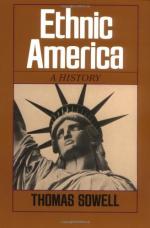
|
| Name: _________________________ | Period: ___________________ |
This test consists of 15 multiple choice questions and 5 short answer questions.
Multiple Choice Questions
1. What "pushed" Mexicans to leave Mexico in the early 20th century?
(a) Religious suppression.
(b) The Mexican revolution.
(c) The devaluation of the peso.
(d) Overcrowding.
2. By 1970, which city had the most Puerto Ricans?
(a) Miami.
(b) San Juan.
(c) Boston.
(d) New York.
3. How did many of the Japanese regard the United States during the 19th century?
(a) As an "earthly paradise."
(b) As the "home of our enemies."
(c) As a "deprived nation."
(d) As a "hell on earth."
4. What type of immigrant group is most likely to retain a foreign language and culture?
(a) Those who are mistreated by mainstream governmental agencies.
(b) Those with back-and-forth migration.
(c) Those whose culture is not represented in the U.S.
(d) Those who are discriminated against.
5. Among all ethnic groups in the U.S., Puerto Ricans in 1930 had the highest rate of what factor?
(a) Birth.
(b) Years of education.
(c) Immigration.
(d) Juvenile delinquency.
6. Under the Gentleman's Agreement, ____________limited the number of Japanese immigrants to the U.S.
(a) Japan.
(b) An international tribunal.
(c) The United States.
(d) The job market.
7. What was a "picture bride"?
(a) A bride who spoke no English.
(b) A perfectly beautiful bride.
(c) A bride from Japan accepted on the basis of a photograph.
(d) A bride from the U.S. accepted on the basis of a photograph.
8. How long is the border between the U.S. and Mexico?
(a) Exactly 1,120 miles.
(b) Less than 1,000 miles.
(c) More than 2,000 miles.
(d) Around 3,000 miles.
9. In California, Japanese immigrants initiated what two business models?
(a) Restaurants and dance academies.
(b) Contract gardening and produce markets.
(c) Language schools and bakeries.
(d) Market gardens and ornamental horticulture.
10. How does the Chinese America crime rate compare to other immigrant groups?
(a) It is unusually low.
(b) It is comparable to the mainstream of society.
(c) It is exceptionally erratic, changing every year.
(d) It is unusually high.
11. What drug was introduced in the U.S. by Chinese immigrants?
(a) Heroin.
(b) Cocaine.
(c) Marijuana.
(d) Opium.
12. What was a "tong?"
(a) A tool for Chinese cooking.
(b) A Chinese riddle.
(c) A Chinese secret society.
(d) A Chinese overlord.
13. What historical events at the turn of the century raised Japanese confidence?
(a) Accumulating more wealth than other Asian nations.
(b) Being twice voted most popular tourist destination.
(c) Winning Nobel prizes for science and math.
(d) Winning wars against China and Russia.
14. Where was the first Puerto Rican community in New York?
(a) The Bronx.
(b) Spanish Harlem.
(c) Long Island.
(d) Brooklyn.
15. What did the Japanese government do when immigrants to Hawaii were unhappy with working conditions?
(a) Banned them from returning to Japan.
(b) Compensated them for lost wages.
(c) Started a war with Hawaii.
(d) Repatriated them.
Short Answer Questions
1. Heightened, more militant group consciousness typically appears in which generation?
2. What vices were commonly available in Chinatown?
3. After the 1906 earthquake, when 10,000 Japanese were left homeless, how many applied for public relief?
4. How were Japanese immigrants treated initially?
5. What was a Californio?
|
This section contains 504 words (approx. 2 pages at 300 words per page) |

|




